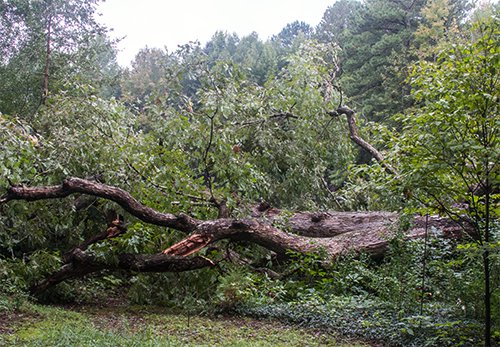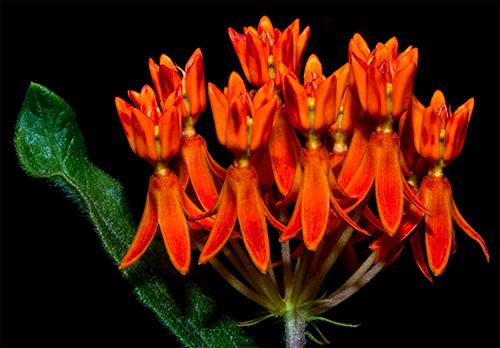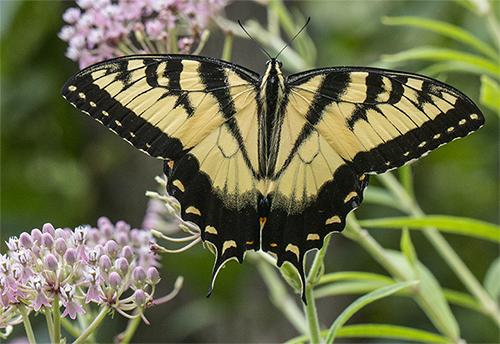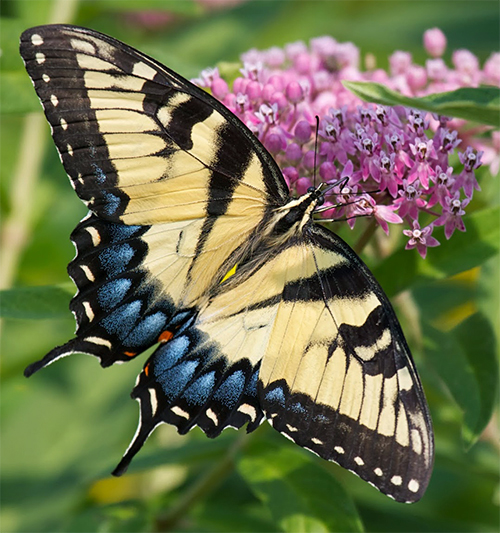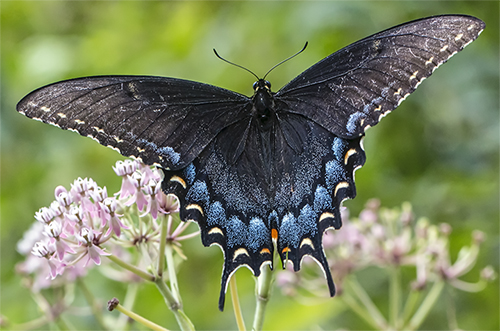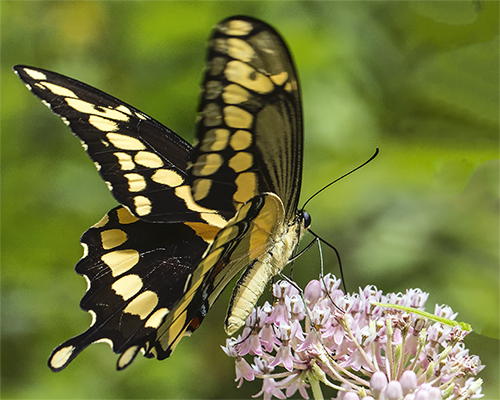- Established 1982 -HOME: www.hiltonpond.org
THIS WEEK at HILTON POND Subscribe for free to our award-winning nature newsletter (Back to Preceding Week; on to Next Week) |
SWALLOWTAILS & SWAMP MILKWEED This August from the old farmhouse at Hilton Pond Center we could see only part of our one-acre impoundment, largely because a near-mountain of vegetation had sprouted on the near bank. In past years we kept most of this greenery cut back to allow a more scenic view, but things changed after a giant White Oak snapped at the base and toppled back in September 2014 (see below).
All text, maps, charts & photos © Hilton Pond Center Although we were able to harvest most of the tree's branches for firewood, the main trunks were so massive we had to let them be--wherein lies the problem: It's almost impossible to safely scramble and climb on these fallen trunks to cut vines, shrubs, saplings, and weedy growth surrounding them.
All text, maps, charts & photos © Hilton Pond Center As we surveyed this pond-side jungle from our office window, we noticed considerable movement that--through binoculars--turned out to be a swarm of butterflies feeding on Swamp Milkweed (above). Somehow, in the midst of vigorous, rambunctious growth this native wildflower was prospering and attracting brightly colored nectar-seeking insects.
All text, maps, charts & photos © Hilton Pond Center Hustling downhill toward the pond for a closer view, we found at least a dozen Eastern Tiger Swallowtails (above) nectaring on blossoms of Swamp Milkweed that first appeared on the banks of Hilton Pond about 20 years ago. Undoubtedly disseminated by wind, the original plants' plume-like seeds landed in damp soil along the pond margin and germinated, establishing several small colonies like this one that continue to grow.
All text, maps, charts & photos © Hilton Pond Center Milkweeds, in general, are famous because folks know they are host plants for charismatic Monarch butterflies, whose larvae dine almost exclusively on noxious milkweed leaves--thereby acquiring a toxin that makes them unpalatable to birds and other potential predators. In locales a bit more northerly than Hilton Pond, Common Milkweed, Asclepias syriaca, is the species most often used by ovipositing Monarchs, while here in the Southeast it seems Butterfly Weed, A. tuberosa, and Swamp Milkweed, A. incarnata (above), are the most likely Monarch caterpillar hosts. (NOTE: Some southern gardeners have been able to propagate and establish Common Milkweed from seed; our local attempts at this have been unsuccessful.)
All text, maps, charts & photos © Hilton Pond Center During the first half of August 2019 we spent several pleasant days in the Center's biggest Swamp Milkweed patch, just watching butterflies come and go. Mesmerized, we also remembered to take a few photos. Unlike years past, we never saw a Monarch, but plentiful Eastern Tiger Swallowtails, Papilio glaucus, more than made up for their absence. Our census indicated males swallowtails (above) outnumbered females about 3:1.
All text, maps, charts & photos © Hilton Pond Center In the minority but more colorful, Yellow-morph female Eastern Tiger Swallowtails (above) are easily differentiated from male conspecifics. Look for metallic blue scales adjoining the "tails" on on the dorsal surface of a female's hindwings.
All text, maps, charts & photos © Hilton Pond Center Interestingly, among Eastern Tiger Swallowtails there is also a black morph (above); these are always female. (You know the dark individual above is female because of blue on the hindwings.) An inventory of our local milkweed colony indicated yellow swallowtails outnumbered black morphs about 10:1. As shown above, these dark females had well-worn forewings, perhaps because males seemed to spend a lot of time chasing them around. It may be easier for males to recognize dark morphs as being female. Despite the swallowtails' seemingly unquenchable thirst for Swamp Milkweed nectar, we won't be finding their eggs on those particular plants. Although milkweeds are essentially obligatory for Monarch caterpillars, Eastern Tiger Swallowtail larvae dine on diverse deciduous woody plants including, among others, the Yellow Poplar, Black Cherry, and White Ash that are quite plentiful at Hilton Pond Center.
All text, maps, charts & photos © Hilton Pond Center Monarchs didn't appear this year on our Swamp Milkweed, but other butterflies besides swallowtails did come to uncoil their probosces and sip nectar. Among those were two kinds of skippers, much smaller species whose rapid movements--usually at grass-top level--affirm their name and make them harder to photograph or identify on the wing. One species was the Clouded Skipper, Lerema accius (female, above), which is probably our most common Hilton Pond skipper. This species ranges from the southeastern U.S. all the way to Venezuela. Clouded Skippers are noted to be early risers, getting out and about before other skipper species are wiggling their antennae.
All text, maps, charts & photos © Hilton Pond Center Our second skipper was a male Zabulon Skipper, Poanes zabulon, a highly variable species that also goes by the much-less-poetic name of Southern Dimorphic Skipper. (The origin of the species name, given in 1837 by French entomologists from a specimen they discovered in Georgia, is unclear.) Males of this species tend to fly higher than other skippers; we sometimes encounter them perched on tree leaves overhanging our trails. Although adults take nectar from a variety of flowers, numerous grasses are the hosts plants for Zabulon Skipper larvae.
All text, maps, charts & photos © Hilton Pond Center Even though we certainly enjoyed observing the antics of our Swamp Milkweed butterflies, our appreciation for their aesthetics was suddenly interrupted one afternoon when a DIFFERENT black swallowtail fluttered into our field of view. At first glance we thought it was an oddly colored dark-morph female Eastern Tiger Swallowtail, but we quickly realized this individual bore lots of yellow spots instead of tiger stripes. Aha! It was a Giant Swallowtail, Papilio cresphontes, the largest butterfly in North America and a new species for our local list!
All text, maps, charts & photos © Hilton Pond Center Fortunately, our camera with macro lens was at the ready and we were able to capture a few quick photos--including the slightly-out-of-focus image just above that shows the Giant Swallowtail's characteristic orange and blue hindwing spots. We weren't able to get a shot revealing the undersides of all four wings are mostly pale yellow, like the body. This fast-flapping butterfly departed as quickly as it arrived, apparently less interested than Eastern Tiger Swallowtails in probing Swamp Milkweed flowers. Regardless, our fleeting experience with the Giant Swallowtail was pretty exciting; after 38 years it's not often we identify a new species for ANY taxonomic group at Hilton Pond Center, including butterflies. All text, maps, charts & photos © Hilton Pond Center POSTSCRIPT #1: We saw at least one more Giant Swallowtail flying at the Center during the last week of August, well after Swamp Milkweed had stopped blooming; it rapidly flitted about and we were able to fire off only one photo (below, feeding on Abelia sp.) that does show the mostly yellow undersides of the wings. It may have just been seeking nectar sources, but it also might have been a female trying to find appropriate host plants on which to lay her eggs (one at a time, rather than in clusters like many insects). We're not sure how successful she would be, because to our knowledge none of the reported host plants below occur on the 11 acres around Hilton Pond.
All text, maps, charts & photos © Hilton Pond Center POSTSCRIPT #2: Gleaned from various sources, here's a list of flora that grow in the southeastern U.S. and can meet nutritional needs of Giant Swallowtail larvae: Hercules' Club (Zanthoxylum clava-herculis); Prickly-ash (Z. americanum); Wild Lime (Z. fagara); Common Hop Tree/Wafer Ash (Ptelea trifoliata); various citrus, including Lemon (Citrus limon), Orange (C. sinensis), Bitter Orange (C. aurantium), and Pummelo (C. maxima); and, the herb Common Rue (Ruta graveolens). POSTSCRIPT #3: In October 2019 we got a note from Dr. Dennis Forsythe, South Carolina Ebutterfly Reviewer, informing us that our 14 August 2019 sighting of the Giant Swallowtail was the first record of this species for York County SC! Who knew? POSTSCRIPT #4: We enhanced the Giant Swallowtail image just above using a "Portrait" filter included in a copy of Luminar 3 donated to Hilton Pond Center by Skylum Software. We look forward to using this Photoshop plug-in to make our images more legible and more representative of what we actually see in nature but sometimes have difficulty rendering accurately on our Web pages. We greatly appreciate the donation and encourage our supporters to try out a trial version available from Skylum. All text, maps, charts & photos © Hilton Pond Center
Checks also can be sent to Hilton Pond Center at: All contributions are tax-deductible on your Don't forget to scroll down for Nature Notes & Photos, |
|---|
|
"This Week at Hilton Pond" is written and photographed by Bill Hilton Jr., executive director of Hilton Pond Center for Piedmont Natural History
|
|
|
Please refer "This Week at Hilton Pond" to others by clicking on this button: |
|

